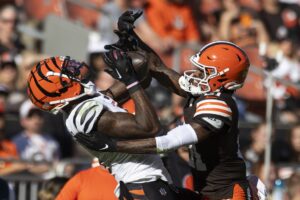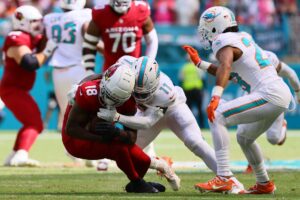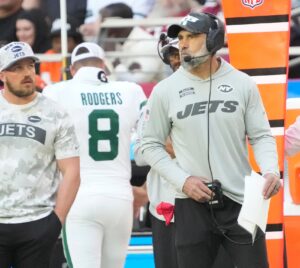For the final installment of where and how the Chicago Bears could go about retooling the roster for the 2020 season, our focus shifts to the secondary. The unit took a step back in 2019 after being a strength in 2018. Some of that was due to shuffling in the front-seven, but there was plenty of blame to be placed on individuals.
Retooling the Chicago Bears Secondary
Full House
The first place we have to look is to the Bears All-Pro cornerback, Kyle Fuller. He was still a Pro Bowler this past season but he was worse almost across the board. Again, some of that has to go on the disarray of the Bears front and, thus, the pass rush. But the numbers on Fuller paint a picture of the player many thought he was before his breakout.
During the run to the Wild Card, Fuller intercepted seven passes and defended 21 more, both league-highs. His advanced stats were even more impressive. Fuller was the most targeted defensive player in 2018 seeing 121 passes thrown his way, per Pro Football Reference. He allowed a meager 56.2 percent to be completed and a 63.7 passer rating.
2019 wasn’t nearly as kind. Fuller allowed 70 percent of the passes thrown his way to be completed and a 102 passer rating. He allowed 134 more yards, one more touchdown, over two yards per target more, and nearly one yard more per completion with three picks being targeted 15 fewer times. He also got in on the team-wide trend of missing tackles this season.
Royal Flush
Fuller wasn’t alone in his regression this season. Prince Amukamara, once a settling presence opposite Fuller, found himself burned time and time again in 2019. He even got benched at points late in the season in favor of Kevin Toliver. Amukamara, the former New York Giants first-round pick and Jacksonville Jaguars starter, is in real danger of not being in Chicago next season.
Amukamara had a strong 2018 similar to his corner cohort. He allowed just over 57 percent of passes his way to be completed, picking off three and swatting down 12 additional throws. He also appeared in 15 contests, his most since the 2013 season, his third with the Giants.
Flash forward to 2019 and it’s still a similar story to Fuller’s. Amukamara didn’t pick off any passes and allowed greater than 66 percent of passes and a 105 passer rating in his coverage. His yards per completion and target both rose nearly three yards. Perhaps the most disappointing part is he continued the trend of allowing more on fewer targets.
Skrine Game
When Buster Skrine was signed in the off-season to replace fan-favorite (but oft-injured) Bryce Callahan, the immediate response was to his reputation for incurring penalties. After he led the New York Jets with seven enforced against him in 2018, including three pass interference calls, rightfully so. But he only had one in all of 2019 with the Bears.
Skrine was just as good elsewhere statistically. He allowed 59.3 percent completion (down from 65.3 percent) and 91.8 passer rating (down from 105.7) in 2019. Skrine was the only one of the Bears three primary cornerbacks that saw his yards gross yards, yards per target, and yards per completion fall year-over-year.
Some of Skrine’s success was predicted based on being surrounded by better talent than he ever has. Still, his three-year, $16 million deal looks like more of a bargain than the regrettable pact it was viewed as in some spaces. The proposed battle between Skrine and rookie Duke Shelley never materialized and that was mostly due to Skrine playing well.
E-Jack of All Trades
By most accounts, safety Eddie Jackson had a down season in 2019. An All-Pro in 2018, Jackson’s 2019 looked awfully similar to Fuller’s. A lot of down numbers partly due to the lack of a consistent pass rush. Unlike Fuller, though, the other major factor for Jackson’s down campaign was due to playing out of position.
Jackson spent last season playing the strong safety role. That resulted in a season where he statistically resembled former Bears safety, Adrian Amos. In other words, Jackson was still solid. But he was far less of the playmaker fans had become accustomed to.
He still had a higher completion percentage allowed and passer rating in conjunction with fewer takeaways (six interceptions and one recovered fumble in 2018, two interceptions and on recovery in 2019). But he was one of the only secondary members to miss fewer tackles than the season before.
Laughing Last
The only addition the Bears made in 2019 that came close to the reaction Skrine’s signing drew was that of Ha Ha Clinton-Dix. A mid-2018 trade to the Washington Redskins and the former Green Bay Packers safety’s reputation for avoiding contact had many who cover and follow the Bears leery. Whether or not they were happy after the season depends on perspective.
When framed only against his own production (and that reputation) 2019 was a solid year for Clinton-Dix. He led the team in takeaways, recording two interceptions (one returned for a touchdown) and two fumble recoveries. If viewed through the prism of his impact on those around him, some may be turned off by his moving Jackson out his best possible role.
Clinton-Dix proved to be worth every bit of his $3.25 million price tag in 2019. He also proved to be worth more, both in terms of money and contract length. The logic behind having two ball-hawking safeties makes sense but taking away Jackson’s ability as a playmaker is a bigger detriment than what Clinton-Dix brings.
Guessing on the Bears Secondary
Chicago has already begun to make moves in the secondary. They inked CFL cornerback Tre Roberson from the Calgary Stampeders, widely regarded as the Canadian league’s top free agent. His two-year contract is modest but the signing is thought to be a signal that Amukamara’s time is up with Chicago’s need for a replacement for Clinton-Dix and his own dip in production.
How the off-season shakes out for the Bears secondary remains to be seen. But there will be at least one new starter and it’s looking more and more likely there could be two. With limited draft capital and financial flexibility and multiple other needs, it will be interesting to see how much of those resources they pour into the unit.
Main Photo:
Embed from Getty Images






